Capybara
| Capybara | |
|---|---|
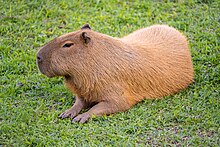
| |
| In Petrópolis, Brazil | |
| Scientific classification | |
| Domain: | Eukaryota |
| Kingdom: | Animalia |
| Phylum: | Chordata |
| Class: | Mammalia |
| Order: | Rodentia |
| Family: | Caviidae |
| Genus: | Hydrochoerus |
| Species: | H. hydrochaeris
|
| Binomial name | |
| Hydrochoerus hydrochaeris | |
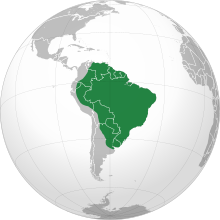
| |
| Native range | |
| Synonyms | |
|
Sus hydrochaeris Linnaeus, 1766 | |
The capybara
Etymology
Its common name is derived from Tupi ka'apiûara, a complex agglutination of kaá (leaf) + píi (slender) + ú (eat) + ara (a suffix for agent nouns), meaning "one who eats slender leaves", or "grass-eater".[4] The genus name, hydrochoerus, comes from Greek ὕδωρ (hydor "water") and χοῖρος (choiros "pig, hog") and the species name, hydrochaeris, comes from Greek ὕδωρ (hydor "water") and χαίρω (chairo "feel happy, enjoy").[5][6]
Classification and phylogeny
The capybara and the lesser capybara both belong to the subfamily Hydrochoerinae along with the rock cavies. The living capybaras and their extinct relatives were previously classified in their own family Hydrochoeridae.[7] Since 2002, molecular phylogenetic studies have recognized a close relationship between Hydrochoerus and Kerodon, the rock cavies,[8] supporting placement of both genera in a subfamily of Caviidae.[5]
Paleontological classifications previously used Hydrochoeridae for all capybaras, while using Hydrochoerinae for the living genus and its closest fossil relatives, such as Neochoerus,[9][10] but more recently have adopted the classification of Hydrochoerinae within Caviidae.[11] The taxonomy of fossil hydrochoerines is also in a state of flux. In recent years, the diversity of fossil hydrochoerines has been substantially reduced.[9][10] This is largely due to the recognition that capybara molar teeth show strong variation in shape over the life of an individual.[9] In one instance, material once referred to four genera and seven species on the basis of differences in molar shape is now thought to represent differently aged individuals of a single species, Cardiatherium paranense.[9] Among fossil species, the name "capybara" can refer to the many species of Hydrochoerinae that are more closely related to the modern Hydrochoerus than to the "cardiomyine" rodents like Cardiomys.[11] The fossil genera Cardiatherium, Phugatherium, Hydrochoeropsis, and Neochoerus are all capybaras under that concept.[11]
Description
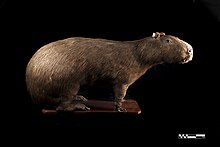
The capybara has a heavy, barrel-shaped body and short head, with reddish-brown fur on the upper part of its body that turns yellowish-brown underneath. Its sweat glands can be found in the surface of the hairy portions of its skin, an unusual trait among rodents.[7] The animal lacks down hair, and its guard hair differs little from over hair.[12]

Adult capybaras grow to 106 to 134 cm (3.48 to 4.40 ft) in length, stand 50 to 62 cm (20 to 24 in) tall at the
Its
Ecology


Capybaras are semiaquatic mammals[15] found throughout all countries of South America except Chile.[19] They live in densely forested areas near bodies of water, such as lakes, rivers, swamps, ponds, and marshes,[14] as well as flooded savannah and along rivers in the tropical rainforest. They are superb swimmers and can hold their breath underwater for up to five minutes at a time. Capybara have flourished in cattle ranches.[7] They roam in home ranges averaging 10 hectares (25 acres) in high-density populations.[7]
Many escapees from captivity can also be found in similar watery habitats around the world. Sightings are fairly common in Florida, although a breeding population has not yet been confirmed.[20] In 2011, one specimen was spotted on the Central Coast of California.[21] These escaped populations occur in areas where prehistoric capybaras inhabited; late Pleistocene capybaras inhabited Florida[22] and Hydrochoerus hesperotiganites in California and Hydrochoerus gaylordi in Grenada, and feral capybaras in North America may actually fill the ecological niche of the Pleistocene species.[23]
Diet and predation
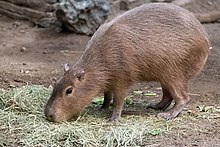
Capybaras are
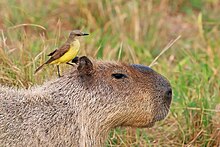
Like its relative the guinea pig, the capybara does not have the capacity to synthesize vitamin C, and capybaras not supplemented with vitamin C in captivity have been reported to develop gum disease as a sign of scurvy.[30]
They can have a lifespan of 8–10 years,
Social organization

Capybaras are known to be
Capybaras have two types of
Reproduction


When in
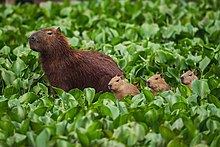
Capybara gestation is 130–150 days, and produces a litter of four young on average, but may produce between one and eight in a single litter.[7] Birth is on land and the female rejoins the group within a few hours of delivering the newborn capybaras, which join the group as soon as they are mobile. Within a week, the young can eat grass, but continue to suckle—from any female in the group—until weaned around 16 weeks. The young form a group within the main group.[19] Alloparenting has been observed in this species.[34] Breeding peaks between April and May in Venezuela and between October and November in Mato Grosso, Brazil.[7]
Activities
Though quite agile on land, capybaras are equally at home in the water. They are excellent swimmers, and can remain completely submerged for up to five minutes,[14] an ability they use to evade predators. Capybaras can sleep in water, keeping only their noses out. As temperatures increase during the day, they wallow in water and then graze during the late afternoon and early evening.[7] They also spend time wallowing in mud.[18] They rest around midnight and then continue to graze before dawn.[7]
Conservation and human interaction
Capybaras are not considered a threatened species;[1] their population is stable throughout most of their South American range, though in some areas hunting has reduced their numbers.[14][19] Capybaras are hunted for their meat and pelts in some areas,[39] and otherwise killed by humans who see their grazing as competition for livestock. In some areas, they are farmed, which has the effect of ensuring the wetland habitats are protected. Their survival is aided by their ability to breed rapidly.[19]
Capybaras have adapted well to urbanization in South America. They can be found in many areas in zoos and parks,
Capybaras are farmed for meat and skins in South America.[42] The meat is considered unsuitable to eat in some areas, while in other areas it is considered an important source of protein.[7] In parts of South America, especially in Venezuela, capybara meat is popular during Lent and Holy Week as the Catholic Church previously issued special dispensation to allow it to be eaten while other meats are generally forbidden.[43] After several attempts a 1784 Papal bull was obtained that allowed the consumption of capybara during Lent.[44][45] There is widespread perception in Venezuela that consumption of capybaras is exclusive to rural people.[46]
Although it is illegal in some states,[47] capybaras are occasionally kept as pets in the United States.[48][b] The image of a capybara features on the 2-peso coin of Uruguay.[50] In Japan, following the lead of Izu Shaboten Zoo in 1982,[51] multiple establishments or zoos in Japan that raise capybaras have adopted the practice of having them relax in onsen during the winter. They are seen as an attraction by Japanese people.[51] Capybaras became popular in Japan due to the popular cartoon character Kapibara-san.[52]
In August 2021, Argentine and international media reported that capybaras had been causing serious problems for residents of
Popularity and meme culture
In the early 2020s, capybaras became a growing figure of meme culture due to many factors, including the disturbances in Nordelta[54] which led to them being comically postulated as figures of class struggle. Also, a common meme format includes capybaras in various situations with the song "After Party" by Don Toliver,[56] leading to a tremendous growth in popularity.[57] Capybaras are also associated with the phrase "Ok I pull up", the opening lyric in Toliver's song.[58]
See also
- Josephoartigasia monesi, an extinct species identified as the largest known rodent ever
- Kurloff cell, a type of cell found in capybaras and guinea pigs
- Capybara Walking, a historical animal locomotion film by Eadweard Muybridge
Notes
- ^ Also called capivara (in Brazil), capiguara (in Bolivia), chigüire, chigüiro, or fercho (in Colombia and Venezuela), carpincho (in Argentina, Paraguay and Uruguay) and ronsoco (in Peru).
- ^ It is illegal to own a capybara in Alaska, California, Colorado, Connecticut, Georgia, Illinois, Massachusetts, New York, Oregon, and Vermont.[49]
References
- ^ . Retrieved 19 November 2021.
- ^ Basic Biology (2015). "Rodents".
- ^ Capybara (Hydrochoerus hydrochaeris) Archived 2012-01-03 at the Wayback Machine. ARKive.org
- Novo Dicionário da Língua Portuguesa, 2nd ed., Rio de Janeiro: Nova Fronteira, p.344
- ^ OCLC 62265494.
- ^ Darwin, Charles R. (1839). Narrative of the surveying voyages of His Majesty's Ships Adventure and Beagle between the years 1826 and 1836, describing their examination of the southern shores of South America, and the Beagle's circumnavigation of the globe. Journal and remarks. 1832–1836. London: Henry Colburn. p. 619.
- In page 57, Darwin says "The largest gnawing animal in the world, the Hydrochærus Capybara (the water-hog), is here also common."
- See it also in The Complete Work of Charles Darwin Online
- ^ S2CID 250991487.
- PMID 11861886.
- ^ a b c d Vucetich, María G.; Deschamps, Cecilia M.; Olivares, Itatí; Dozo, María T. (2005). "Capybaras, size, shape, and time: A model kit". Acta Palaeontologica Polonica. 50 (2): 259–272.
- ^ S2CID 86217854.
- ^ hdl:11336/117299.
- ^ "The Cabybara – 10 Facts About the World's Largest Rodent". WorldAtlas. 26 July 2019. Retrieved 18 March 2020.
- ^ Capybara Archived 2012-01-03 at the Wayback Machine, Arkive
- ^ Smithsonian National Zoological Park. Retrieved on December 16, 2007.
- ^ a b c Capybara. Palm Beach Zoo. Retrieved on December 17, 2007.
- ^ World Association of Zoos and Aquariums. WAZA. Retrieved on 2011-12-07.
- .
- ^ a b "Capybara Printout". Enchantedlearning.com. Retrieved 27 May 2013.
- ^ a b c d e f g Bristol Zoo Gardens (UK) Capybara Archived 2007-09-18 at the Wayback Machine. Bristolzoo.org.uk. Retrieved on 2011-12-07.
- ^ "Nonnatives – Capybara". myfwc.com. Archived from the original on 6 April 2014. Retrieved 30 August 2013.
- ^ Mather, Kate (18 August 2011). "A gnawing question answered: It's a capybara roaming Paso Robles". Los Angeles Times. Retrieved 10 January 2012.
- S2CID 216241471.
- ^ Erick J. Lundgren, Daniel Ramp, John Rowan, Owen Middleton, Simon D. Schowanek, Oscar Sanisidro, Scott P. Carroll, Matt Davis, Christopher J. Sandom, Jens-Christian Svenning, Arian D. Wallach, James A. Estes, 2020, Introduced herbivores restore Late Pleistocene ecological functions, PNAS, 117 (14), pp.7871-7878, Proceedings of the National Academy of Sciences of the United States of America
- PMID 15162749.
- ^ S2CID 83976640.
- S2CID 84982123.
- ^ a b c Capybara. Hydrochaeris hydrochaeris. San Francisco Zoo
- ^ a b "Meet Taronga's Capybaras". Taronga Zoo. Retrieved 29 December 2021.
- ^ .
- S2CID 6491859.
- ISBN 0-7614-7269-X, p. 384
- ^ Capybara, the master of the grasses: pest or prey Sounds and Colours. Retrieved on January 23, 2011.
- .
- ^ .
- .
- ^ .
- ^ .
- PMID 10481304.
- ^ Thompson, Andy (January 18, 2008) Trip to South America gives new meaning to outdoors life. Richmond Times.
- ^ "Febre maculosa: "Os médicos no Brasil não conhecem a doença" [Rocky Mountain spotted fever: Brazilian doctors unaware of the disease] (in Portuguese). drauziovarella.com.br. 12 April 2011. Retrieved 13 August 2015.
- ^ "Conservation at Drusillas Park". Drusillas.co.uk. Retrieved 27 May 2013.
- ^ "Capybara, Hydrochoerus hydrochaeris". San Diego Zoo. October 2008. Archived from the original on 30 September 2011. Retrieved 22 June 2011.
- New York Sun.
- ^ López de Ceballos, Eduardo (1974). Fauna de Venezuela y su conservación. Venezuela: Editorial Arte.
- ISBN 978-1-4614-4000-0.
- ISSN 0362-4331. Retrieved 27 April 2021.
- ^ "Capybaras as Pets". capybarafacts.com. Retrieved 23 October 2014.
- ISBN 978-1-56164-513-8.
- ^ "Pet Capybara Legal States 2023". Retrieved 11 February 2023.
- ^ "2 Pesos Uruguayos de 2014" (in Spanish). Monedas Uruguay. Archived from the original on 7 October 2016. Retrieved 8 June 2016.
- ^ a b "Izu Shaboten Animal Park (Ito) – 2018 All You Need to Know Before You Go (with Photos) – TripAdvisor". www.tripadvisor.com.
- ^ "Capybaras are big in Japan".
- ^ "Capybaras". Know Your Meme. July 2021.
- ^ TheGuardian.com.
- PMID 27769883.
- ^ Lopez, Sophia (1 August 2022). "Capybaras are taking over the internet". The Gauntlet. Retrieved 2 September 2022.
- ^ "Google Trends". Archived from the original on 25 September 2022. Retrieved 30 July 2022.
- Vice. Retrieved 7 August 2022.
External links
- Alan Taylor (29 November 2018). "Companionable Capybaras (18 Photos)". The Atlantic.
- Animal Diversity Web Hydrochoerus hydrochaeris
- Capybara information

